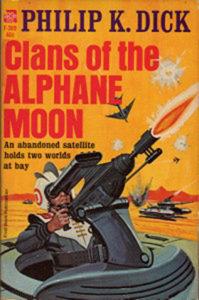“Clans of the Alphane Moon” (1964) has everything I love about a Philip K. Dick novel. It grabbed me from the moment when Chuck Rittersdorf is standing on a ledge, having decided to kill himself, only to be talked down by his telepathic Ganymedean slime mold neighbor who has oozed under his conapt door.
It’s debatable whether stuff like this is purposeful absurdist humor or PKD’s attempt to write SF when it’s not his natural inclination, but the end result is highly entertaining.
Many touchstones
I want to say “Clans” is a good recommendation for someone reading their first PKD novel, simply because so many touchstones are here. In addition to the suicidal low-level bureaucrat whose wife has left him but is still using him as a source of income, and the concerned-neighbor slime mold, we get a young woman who can turn back time 5 minutes in localized spaces, mental patients who can see into the future, remotely guided simulacra, mind-altering drug use, the male lead’s preoccupation with women’s breasts, and a governmental scheme that makes no logical sense yet rings perfectly true.

“Clans of the Alphane Moon” (1964)
Author: Philip K. Dick
Genre: Science fiction
Setting: Undated future, human colony in Alpha Centauri system
But that might be because I’ve read a lot of PKD books and know the rhythms. In the afterword of the Carroll & Graf edition, Barry Maltzberg argues that “Clans” would be indecipherable to newbies. I’d contend that it has a more focused core than some of PKD’s other early works, though. In this novel, PKD doesn’t go off on tangents, leaving other good stuff in the dust (as with “The Game-Players of Titan”).
He stays focused on the central theme: the question of who is crazy and who isn’t. Related questions include “Who defines what ‘crazy’ is?” and “Is ‘craziness’ the only sane response to an insane world?” If that’s the case, then people who are “normal” would actually be the crazy ones.
PKD crystallizes “Clans’ ” theme in chapter 7 in a conversation between CIA simulacrum Mageboom and Dr. Mary Rittersdorf, who has volunteered to go to the titular Alpha III M2 to study the clans who have been free from their mental hospital for 25 years and have formed their own community. It’s broken into distinct towns based on mental afflictions, from Manses (people with mania) to Deps (depressives) to Pares (paranoids) to Ob-Coms (obsessive-compulsives).
Mageboom asks Mary “How is that different from our own society on Terra?” and Mary doesn’t have an immediate answer. I don’t know if PKD is going for a joke there, but it’s a rimshot-worthy summation of the book’s theme.
Who’s really crazy?
Later, “Clans” concludes with a blurring of the lines of who is crazy and who isn’t. I’m not sure it sticks the landing with the revelation that Chuck tests out as normal; I mean, he was going to kill himself earlier. But I see the author’s point about the fine line between “crazy” and “normal.” Chuck himself decides it’s a matter of degree.

While PKD features mentally ill characters in a lot of his works, it’s interesting that he deals with treatment far less. “Clans” is a step in the direction of solutions, because it has that test at the end. I find it interesting, though, that Chuck believes there’s little point in knowing your condition since you can’t change it anyway.
That attitude has shifted in society since 1964. For instance, one of the most appreciated songs on TV’s mental-illness dramedy “Crazy Ex-Girlfriend” is “A Diagnosis,” wherein Rebecca feels better after learning the name of her condition. This makes sense purely on a comfort level: Doctors have heard of your condition, and they aren’t shocked by the fact of the condition. You aren’t the only person on Earth who has it.
Despite Chuck’s dismissal of diagnoses, the Clans do define and categorize themselves, and each other, by their conditions – and they do this on their own, without any extra push from a governing force. The book doesn’t conclude whether this is a good or bad thing. It does give people a sense of identity, but on the other hand, everyone’s first impression of a person is their clan identity.
Defined by their illnesses
It’s quite possible that PKD isn’t making a point here. Rather, he’s taking a tidy shortcut to characterization. For example, Gabriel Baines is paranoid and Ignatz Ledebur is a “Hebe” — hebephrenic (I had to look this one up; it means a severely disorganized person). We quickly learn enough about them for the story’s purpose.
I’m not big on stories about mental patients, although it’s fairly entertaining when the clans get together for a meeting. But wisely, PKD spends most of his time writing about Chuck, the more-or-less normal guy whose story is wild enough. He’s navigating two jobs (for the sake of paying alimony). His second job is as a TV comedy writer for Bunny Hentman. Somehow the CIA gig and comedy-writing gig intersect in a grand conspiracy.
Playing behind all this is the question of who will take legal control of Alpha III M2 – the mental patients, the Alphanes or the Terrans? Even though I just finished the book, I couldn’t describe the goals of each political entity. There are a couple paragraphs where Chuck goes through the entities and their aims as he tries to figure out who is on his side, but even here, I absorbed the humorous absurdity more than the logistics.
Nonetheless, “Clans of the Alphane Moon” is a page-turner … if you’re on the same crazy (or totally sane?) wavelength as PKD.

